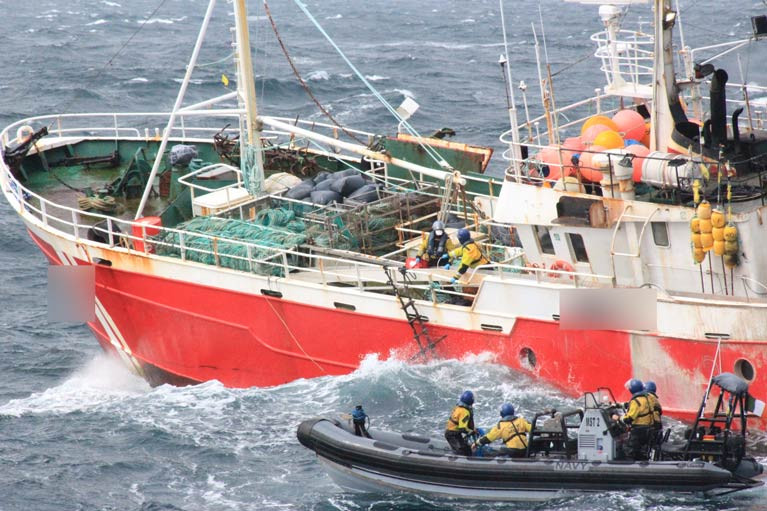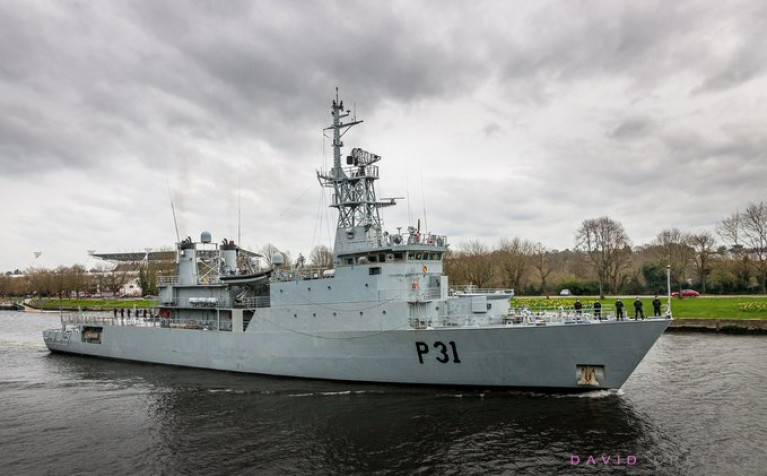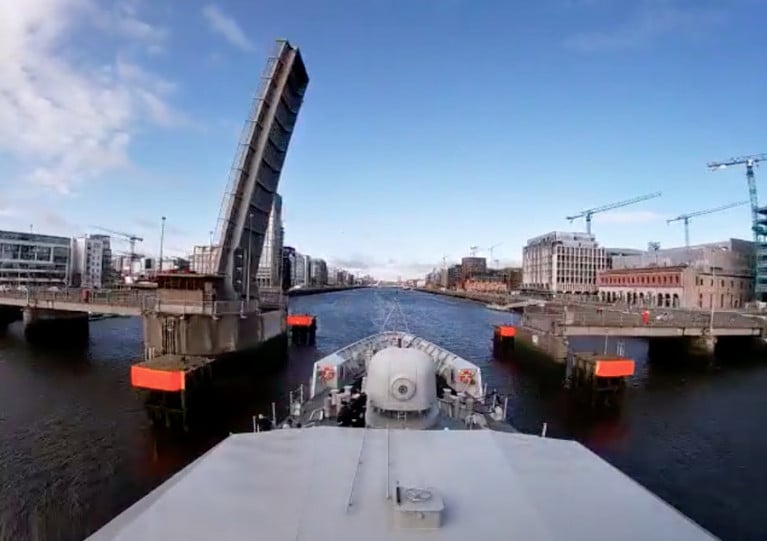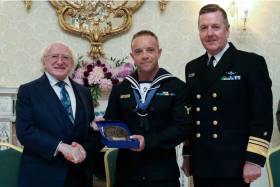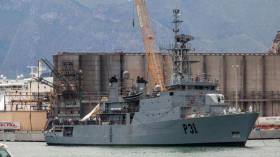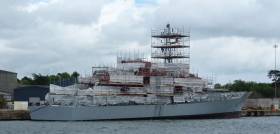Displaying items by tag: naval service
Spanish Vessel Detained by Naval Service Near Rockall Had Allegedly Been in Earlier Confrontation off Scotland
A German-registered Spanish fishing vessel detained last week by the Naval Service near Rockall had been at the centre of an alleged confrontation off the Scottish coast last month.
As The Irish Examiner reports, the 29-metre Pesorsa Dos was detained by Irish navy patrol ship LÉ William Butler Yeats some 250 miles off Malin Head, Co Donegal for “alleged infringements of EU fishing regulations in Irish waters” on July 16th.
Orkney and Shetland MP Alistair Carmichael has highlighted the Irish detention, noting the British authorities said they could not take any action over an incident involving the same Spanish vessel off Scotland.
However, defence force sources have said the Irish detention was for a separate alleged infringement.
Video footage of the gill netter, from the Spanish port of La Coruna, filmed on June 11th, showed it allegedly trying to foul the propeller of a Scottish fishing vessel, Alison Kay, some 30 miles west of the Shetland islands.
The British Maritime and Coastguard Agency (MCA) was urged to investigate the incident, which Scottish skippers claimed to be the latest in a series of such confrontations over fishing grounds.
However, the MCA said it had no jurisdiction to investigate it as it was outside the 12-mile jurisdictional limit in which it could take action against foreign-flagged vessels.
It said its maritime investigations team had written to the German maritime administration “to raise its concerns”, as it was the responsibility of the flag state.
The German federal police department for maritime security has been reported as stating there is “no suspicion of an offence under German law”.
It is understood the vessel was gillnetting near Rockall, and had ten tonnes of monkfish on board when it was boarded and detained by the LÉ William Butler Yeats.
The vessel was escorted to Killybegs, Co Donegal and handed over to the Garda and the Sea Fisheries Protection Agency (SFPA).
Mr Carmichael said the fact that “the Irish authorities were able to detain the Pesorsa Dos entirely undermines the argument of the UK and German authorities that there was nothing to be done about its dangerous activities”.
He told the MCA in a letter that the actions of Spanish fishermen had “caused a great deal of anger and frustration for trawlermen in my constituency and across the north of Scotland in recent years”, due to both “aggressive acts such as those outlined, and the wider use of gill-nets which can cover large areas and thus prevent other fishermen from working in those areas”.
The SFPA said that a 24-hour detention order for the vessel was granted on July 21st at Carrick-on-Shannon district court in Co Leitrim. It said it could not comment further as the case was before the courts. It was the Naval Service’s seventh detention at sea this year.
Read more in The Irish Examiner here
The Naval Service patrol ship LÉ James Joyce prepared to depart Galway port at the weekend, as COVID-19 virus test centres in the west were scaled down.
The LE James Joyce berthed in Galway on April 8th, replacing the LÉ William Butler Yeats which set up the first field hospital in Galway for the Health Service Executive last month (march).
It is understood the test facilities at Galway’s dockside were used minimally over the ten days, and the LÉ James Joyce was informed at the weekend that its services were no longer required.
Two other patrol ships are still providing assistance to the HSE – the LÉ Niamh on Sir John Rogerson’s Quay in Dublin, and the LÉ Eithne on Albert Quay in Cork.
Testing is not taking place at the LÉ Eithne, but the ship’s crew has been assisting with storage of personal protection equipment and decanting hand sanitisers.
.Galway had 273 confirmed cases of the COVID-19 virus as of yesterday, an increase of seven over a 24-hour report period.
Both Galway and Mayo are said to be at the lower end of the scale of confirmed cases of the virus.
The HSE has said it is up to date on COVID-19 test referrals, with waiting time for an appointment at under 24 hours.
Paying tribute to all staff involved, it said that community test centres could be stepped up again if required.
Crew of the LÉ Eithne, which EchoLive.ie reported earlier today, have been tasked to deliver personal protective equipment to HSE locations across Cork city.
The Naval Service vessel is docked in Cork city since March 20, awaiting a tasking from the HSE as part of the Covid-19 operation.
Since Tuesday, the vessel’s crew has been delivering PPE and alcohol-based handrub to numerous locations.
A spokesman for the Defence Forces said the locations change every day.
The LÉ Samuel Beckett (Afloat adds recently taken over by LÉ Niamh) in Dublin and LÉ William Butler Yeats in Galway are already being used as test centres. (Albeit Afloat adds using field tents set up on quaysides)
For more on the story click here.
Afloat previously stated incorrectly that LÉ Eithne is been used as a test centre.
This afternoon Afloat confirmed with the Naval Service which said that LÉ Eithne remains alongside Cork City as part of the Defence Force’s efforts to generate more capacity to help the HSE to fight Covid-19. To date the vessel has not received any tasking relating to a testing centre.
LÉ Samuel Beckett Arrives In Dublin To Shore Up HSE Capacity In Fight Against Covid-19
Naval Service vessel the LÉ Samuel Beckett arrived in Dublin this morning (Sunday 15 March) as part of Óglaigh na hÉireann’s efforts to generate more capacity to help the HSE during the current Covid-19 response.
The Irish Defence Forces said: “P61’s facilities, resources and crew will be ready when requested by primary response agencies to fight Covid-19.”
The latest guidelines for the public are available on the HSE website HERE.
In an urgent need to address gaps in maritime and air security, and the threat posed by cyber attacks, they feature prominently in submissions made to the country's first national security strategy.
A total of 60 submissions have been made in a public consultation launched by the newly-established National Security Analysis Centre.
The NSAC, based within the Department of the Taoiseach, is drawing up the State's first-ever National Security Strategy.
While the submissions have not yet been published by the department a number are available on the websites of bodies that have made them
In its detailed submission, the Association of Retired Commissioned Officers (ARCO) said the threats to Ireland's national security range from energy security, espionage and extremism to hybrid warfare, major pandemics, nuclear contamination and terrorism.
The submission, authored by Brigadier-General Paul Pakenham (Retd), said that ISIS is “likely to reemerge in the short to medium term”.
It said the concept of military neutrality was “flawed and outdated” and that cyber-enabled attacks and hybrid warfare “do not respect Ireland's military neutrality posture".
ARCO said a “substantial increase” in investment in defence capabilities is required, pointing out that Ireland has the lowest defence spend in the EU, at 0.3% of GDP (average 1.3%).
It said the trans American-European sea and air lanes are in “close proximity” to Ireland and that Ireland's significant reliance on sea lanes presents a potential risk.
The Irish Maritime Forum, an independent professional body, also looked at on sea lanes of communication.
It wants an increased focus, by boosting the Naval Service, to protect Ireland's maritime domain, which is the largest in northwest Europe, with 92% of Ireland's area being underwater.
“We are a small trading nation living on an island and 99% (by volume) of everything we import or export is transported by sea," it said.
“The sea and air traffic between northern Europe and the USA passes close to our shores and through or above waters over which we have jurisdiction or for which we have responsibility.”
Much more from BreakingNews.ie here.
Navy Diver on Migrant Rescue Among Seven Recipients of Defence Forces Value Awards
A Naval Service diver who was involved in migrant rescue in the Mediterranean is one of seven recipients of Defence Forces value awards conferred by President Michael D Higgins on Wednesday evening writes Lorna Siggins
Able Mechanician Ryan O’Driscoll, originally from Rush, Co Dublin, and a Naval Service diver for the past three years, was also involved in the recovery operation after the loss of four Irish Coast Guard air crew in the Rescue 116 crash off north Mayo over two years ago.
The Defence Force value awards aim to celebrate outstanding service, and acknowledge the support and encouragement of the families of the recipients.
Also awarded were Corporal Caitriona Lacey, Gunner David Stack, Corporal David McCormack, Private Thomas Carew, Sergeant PJ McCabe and Regimental Sergeant Major John Murray.
Able Mechanician O’Driscoll served on the Naval Service ship LE Samuel Beckett in the Mediterranean during Ireland’s participation in Operation Pontus, a bilateral rescue initiative with Italy, and the now-suspended EUNAVFOR Med Operation Sophia.
As a diver, he participated in many missions in Irish waters and was directly involved in the recovery of the body of Irish Coast Guard co-pilot Capt Mark Duffy from the wreckage of the R116 helicopter off Blackrock island in north Mayo in March, 2017.
He was described in his citation as being a natural leader who has the respect of his peers.
Private Thomas Carew Private Thomas Carew, from Ferrybank in Waterford, was awarded for his “commendable selflessness” in saving the life of a civilian motorcyclist in a road accident in which he was propelled by the impact of the collision into an estuary in high tide.
Private Carew, from the Army’s 3rd Infantry Battalion, was nominated by a former superior.
Cpl David McCormack from Galway, was nominated by many of his comrades from the 1st Infantry Battalion for his response to an assault which left him with life-threatening injuries after he had returned from overseas service with the UN.
Cpl Catriona Lacey from Athlone, Co Westmeath, was nominated by fellow soldiers in 6th Infantry Battalion, having demonstrated moral courage after the loss of her brother, Thomas, to suicide in 2014.
Her father, Frank served 31 years in the Defence Forces brass band as a bugler and played at former president Eamon De Valera’s funeral. He is retired 20 years.
President Higgins said he was pleased to have been asked by Vice-Admiral Mark Mellett, head of the Defence Forces, to facilitate the event and “to celebrate the outstanding service given by seven deserving awardees”.
“ I am so pleased to have the opportunity of acknowledging in general, the support given by the families of so many members of our defence forces – a support that makes the contribution of their partners possible,” Mr Higgins said.
“You have all displayed a magnanimous resolve and steadfast commitment to uphold the central values of the Defence Forces, and your individual efforts and service to Ireland are being highlighted in this ceremony today,” Mr Higgins said.
UK Councillor Calls to Renationalise Appledore Shipyard
DevonLive reports on Appledore Shipyard which according to a UK councillor should be renationalised by the government and fully integrated into the operations of the Ministry of Defence.
Cllr Rob Hannaford, leader of the opposition Labour group on Devon County Council, put forward the notice of motion to last Thursday’s full council meeting.
His motion said that the council was gravely concerned that despite having a highly skilled, dedicated, and innovative local work force, the shipyard remains closed, and that to secure its long term future, ensure that defence capacity and resilience are maintained, and provide employment and prosperity to the local community, and the wider county of Devon, it should be renationalised.
Appledore Shipyard closed on March 15 this year when Babcock’s lease expired, despite a union-led protest march, a 9,500-strong petition and the efforts of local MPs.
Speaking on the motion, Cllr Hannaford, said: “To see a successful shipyard turn profit year-on-year and then struggle to secure work for this committed workforce is very unfair and a sad travesty. It’s a huge concern that this important local shipyard remains closed – especially as we know that it has an incredibly skilled and innovative workforce.
For more click here on the calls to save the north Devon shipyard (campaign) that built its final ship for the Irish Naval Service.
A Naval Service ship on Mediterranean rescue several years ago was unable to recover a migrant’s body that it had located in the water for several hours until it could confirm which EU state would accept it, a former mission member has recalled writes Lorna Siggins
The crew of the LÉ Samuel Beckett stood by for a total of four hours until eventually, the Maltese authorities agreed, Able Seaman Ian Trimble, a Naval Service diver, has said.
During that time, four EU coastal states in all had been contacted by the ship, he said, but the situation was complicated by the fact that the body was in international waters,
The harrowing experience was one of several recounted by the Naval Service crew, led by Commander Anthony Geraghty, at a Galway International Arts festival “First Thought” talk convened by Caitriona Crowe and chaired by Judy Murphy.
The LÉ Samuel Beckett (italics) was deployed on several missions during Ireland’s deployment of ships on migrant rescue between 2015 and 2018, when almost 18,000 people were rescued, two babies were delivered and 86 bodies were recovered by 11 Irish ships in all.
EU maritime missions were suspended earlier this year, after Italy’s far-right government refused to continue to accept migrants, but aerial reconnaissance continues. Up to 700 people are reported to have drowned this year so far, according to International Organisation for Migration figures, with an estimated 150 dying last week.
Commander Geraghty, who said he would return if Ireland’s assistance was sought as part of a resumed EU effort, described how he could never understand how anybody would get into a vessel with no lifejackets and no flares.
He said he could only conclude that the lives of migrants at home was “so bad that no matter what happens to them, it’s worth it” when risking a crossing at sea.
In his 29 years with the Naval Service, his three-month mission in the Mediterranean had been “the most fulfilling”, he said.
The barges crowded with between 250 and 800 migrants which the Naval Service came across were particularly challenging, as the crew would know that for every person on the top deck there would be many people locked below, Geraghty said.
If the barge capsized, as it regularly did, those locked below in the hold would drown.
Medical sick berth attendant Seán Doyle said most of the injuries he treated were chemical burns from fuel, along with dehydration and exhaustion.
“I don’t think anything really prepared us...I saw things I wouldn’t want to see, and wouldn’t want anyone else to see,”Petty Officer Trish O’Sullivan, an electrician, said.
O’Sullivan, who served on two Mediterranean missions in 2015 and 2016, said that “military rank goes out the window” during a rescue.
“When you are trying to get everyone on board, safety is paramount,” she said, adding that she did between 700 and 800 squats one day while searching people who were being taken on board ship.
While she recovered several nails and blades, most people carried photos, family albums, heirlooms, and food.
“There might be a drawing their daughter had made...and their clothes would be covered in petrol and faeces, “she said.
Some had little or no clothing and “we tried to protect people’s dignity,” O’Sullivan said.
The four LÉ Samuel Beckett crew showed an excerpt from the documentary, The Crossing, directed by Judy Kelly, which was filmed onboard the ship during its first Mediterranean deployment and broadcast in 2016.
The LÉ Samuel Beckett was deployed in 2016 under a bilateral agreement with Italy, Operation Pontus, and latterly in 2018 under the EU NavFOR Med Operation Sophia which was primarily focused on security and disrupting smuggler activity, and on rescue.
Some 600 Naval Service crew, including 40 medical staff with some Army and Air Corps participants, served on the 11 missions, which were an average of three months in duration, and involved an additional tax-free allowance of about €70 a day while aboard.
Last week, non-governmental organisation Medecins Sans Frontieres (MSF) confirmed that it was resuming its rescue operations in the central Mediterranean.
The decision was taken after what the NGO said was a “two-year campaign by virtually all EU governments to stop humanitarian action at sea”.
MSF has also condemned the recent return of migrants, caught at sea by the Libyan Coast guard, to the Libyan Tajoura detention centre which was bombed in July, killing 60 people and injuring many others.
Plans for €200m Navy Ship May be Stalled
The Government may delay plans for a 200 million euro “multi-role” Naval Service ship, amid continuing controversy over crewing shortages for the existing fleet writes Lorna Siggins
A joint civil-military meeting is due to take place today at the direction of Minister of State for Defence Paul Kehoe, which will focus on “Naval Service capability and operations” according to his department.
Mr Kehoe has asked his officials and military representatives to “fully explore all options to address the challenges in the Naval Service” at the end of a fortnight during which Mr Kehoe and Taoiseach Leo Varadkar differed initially over why three ships are tied up.
Commodore Malone stated in a Defence Force newsletter in June that 540 personnel had left the service in the past five years, and he had decided “to place two ships in an operational reserve capacity” due to the staff shortages.
These two ships, the LÉ Eithne and LÉ Orla, are still in “operational reserve”, according to the department, while the LÉ Roisín is tied up for a mid-term refit.
Government policy is to maintain a nine-ship fleet – the largest ever in defence wing’s history – and the department says the Naval Service has 88 per cent of its establishment, as in 996 staff as of May 31st this year, compared to an establishment figure of 1,094 staff.
Ordering a new multi-role vessel to replace the flagship, LÉ Eithne is provided for in the Government’s White Paper on Defence as part of a commitment to “ongoing renewal and replacement of naval vessels”, the department says.
The new vessel is a “very significant project”, the department says, but it is still “at the planning stage”.
“Accordingly, no public procurement competition tender documentation has issued to the market at this stage,” the department says.
“ As a longer-term project, it will involve a number of years to completion,” it says.
Minister Kehoe “has a particular focus at present on restoring the Naval Service to full personnel strength”, the department says.
During a Dáíl debate last month (June 13th) on defence forces remuneration, Mr Kehoe said it was “important that we continue to invest in training and equipment” in the military.
During the debate, former Independent TD Mick Wallace referred to National Development Plan capital investment of 541 million euro in defence between 2018-2022 and accused Mr Kehoe of “throwing money at things like new ships for the Naval Service”
A 200 million euro multi-role vessel has “less to do with the Naval Service being able to fulfil its day-to-day duties and much more to do with trying to impress our European colleagues in the Mediterranean”, Mr Wallace said during the debate.
“The multi-role vessel will be capable of carrying a battalion of soldiers along with landing craft. It will also have freight capacity for military vehicles. What in God's name do we need that for? The Minister of State would be better off paying the Defence Forces personnel,” Mr Wallace continued.
On October 3rd, 2018 Independent TD Seamus Healy called on Mr Kehoe to “scrap” plans for the multi-role vessel in the light of the “current position on pay and conditions of employment in the defence forces.
“I do not believe we should scrap the project,” Mr Kehoe responded to Mr Healy.” This is a commitment from the Government. We will continue until tendering stage.”
“ When we get to that stage we will look at the resource envelope available to the Defence Forces. I make no apologies for equipping members of the Defence Forces with the very best equipment,” Mr Kehoe said last October.
The European Commission has received no formal notification to date that Irish fishery protection has been affected by Naval Service crew shortages writes Lorna Siggins
Three ships are currently tied up in port, and Paul Kehoe, Minister of State with special responsibility for Defence, has directed his officials and military management to meet on Friday to “fully explore all options to address the challenges in the Naval Service”.
Sources close to the European Commission said that the Commission had received no official information from Ireland indicating that the Naval Service is having crewing difficulties.
The EU has allocated over €37 million to Ireland between 2014 and 2020 to conduct control and enforcement as part of the EU Common Fisheries Policy.
Naval Service personnel and Sea Fisheries Protection Agency (SFPA) officers act as EU “community inspectors” in the Irish exclusive economic zone, with the aim of having two to three ships at sea at any one time.
Asked to comment on the impact on fishery protection of crewing shortages, the SFPA said that fishery patrol inspections by the Naval Service are “risk-based” with a greater focus on “quality of inspections rather than the quantity”.
The Department of Defence is continuing to maintain that three of the Naval Service’s fleet of nine ships are tied up for maintenance or refit, and are still in “operational reserve” during this period, in spite of statements to the contrary by the Taoiseach and by the Naval Service’s Commodore Michael Malone.
Commodore Malone stated in a Defence Force newsletter in June that 540 personnel had left the service in the past five years and he had decided “to place two ships in an operational reserve capacity”due to the staff shortages.
Taoiseach Leo Varadkar initially agreed with Commodore Malone’s version of events, but told the Dáil on Tuesday that Mr Kehoe’s version was also accurate.
Two decorated former Naval Service officers - former Commander Eugene Ryan and former Captain James Robinson - called on Mr Kehoe this week to resign.
The department says that the LÉ Roisín is going through a “mid-life refit”, while the LÉ Eithne and LÉ Orla are “going through planned maintenance and their crews will be redeployed”.
“That means that three ships will be held in operational reserve or in maintenance and the remaining six vessels are fully operational, “the department says.
“The Government is fully mindful of the staffing and personnel issues that are facing the Naval Service,”it said, and this was why a meeting between department officials and military management would take place on Friday to “fully explore all options to address the challenges in the Naval Service”.
“The Government’s whole focus is returning the Naval Service to its full capacity,”it said.
The department said that the Naval Service still had 88 per cent of its establishment, as in 996 staff as of May 31st this year, compared to an establishment figure of 1,094 staff.
It said that there had been 165 departures since July 2018, with 22 personnel, or 13.33% of those that left, not having completed their induction training.
The crew shortages are now placing a question mark over the tender for a “multi-role” Navy ship, costed at around 200 million euro, which is included in the Government’s white paper. The ship is intended to replace the LÉ Eithne.
Three of Haulbowline’s nine ships have been built since 2014, making it the largest ever Naval Service fleet since 1946.
On October 3rd, 2018 Independent TD Seamus Healy called on Mr Kehoe to “scrap” plans for the multi-role vessel in the light of the “current position on pay and conditions of employment in the defence forces” and because it might be used in “aggressive military operations” in the Mediterranean. T
The Government is no longer providing a Naval Service ship for Mediterranean rescue.
“I do not believe we should scrap the project,” Mr Kehoe responded to Mr Healy.” This is a commitment from the Government. We will continue until tendering stage. When we get to that stage we will look at the resource envelope available to the Defence Forces. I make no apologies for equipping members of the Defence Forces with the very best equipment.”



























